Nearing the end of a long work week in January 2022, Dewey Coffey of Casey County, Kentucky, began doing a job he’d done dozens of times — loading out a truck of soybeans from his grain bin. Plagued by hulls that kept clogging the auger, Coffey completed another task he’d done numerous times — climbed inside the 12,000-bushel grain bin to see what the problem was. After climbing into the bin, he proceeded to use a piece of PVC pipe to keep the beans flowing while pushing hulls to the side.
It was at this point that Coffey’s run-of-the-mill day took a drastic turn.
“All of a sudden, I got sucked down into the center of the bin and couldn’t move,” Coffey said. Not knowing that the tractor-trailer driver had climbed back in the truck to pull it up, Coffey said he began yelling for him to shut the auger off. There was no response.
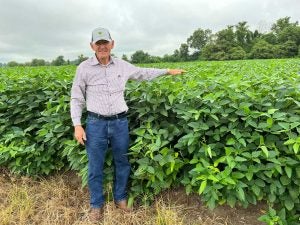
“I couldn’t lift either foot up, and I was going down faster than I wanted to be,” Coffey said. “I knew my foot was getting fairly close to the auger. It went through my head that if he didn’t get it turned off quick, it wasn’t going to be good for me.”
It wasn’t until the driver got out of the truck and saw the auger belt smoking that he knew something was wrong and immediately shut off the power switch. The smoking was caused by the PVC pipe, which had gotten caught in the auger as Coffey was sucked down.
An unlikely statistic
In another part of the county, Brandon Long, chief of the Liberty-Casey County Rescue Squad, had just returned home from his 40-hour a week job when he heard the tones go off and the dispatcher say a farmer was caught in a grain bin. Long — a volunteer firefighter for 22 years, with 18 of those on the rescue squad — was a seasoned rescuer and knew what was at stake.
“When I heard ‘grain bin’ my mind went racing,” he said. “You hear about it, you know about it. You know the statistics for a positive turnout.”
According to research from Purdue University, an estimated 62 percent of documented grain entrapments result in death.
“When I have a car wreck, you may have five or six guys there,” Long said. “When you hear ‘grain bin’, that’s why so many people came out to help. You know it’s going to be more than 30 minutes.”
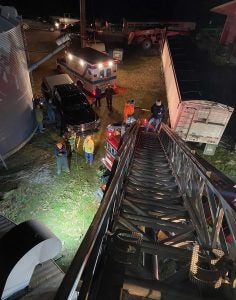
Long estimates that 40 volunteers from the nearby fire departments and the Liberty-Casey County Rescue Squad showed up to help that day.
And 40 folks is what it took to run all the different necessities to facilitate the rescue. There were rescuers on communications and dispatch, others checking safety, folks running trucks, and four active members doing the rescue with two people on the ropes for each person inside. Volunteers from numerous surrounding counties were also headed their way to assist before the rescue was completed.
Tools for the job
The Coffey rescue is the first time anyone in Casey County has been in a real-life grain bin rescue. Up until five years ago, they wouldn’t have even had the tools to do it.
Only within the last two decades have grain bins been a normal site on family farms in Casey County. Prior to then, this was tobacco country. As tobacco died out, grain became the common crop with grain bins popping up on small family farms. In the last five to 10 years, rescuers in the area realized the need to be prepared for the possibility of a grain rescue.
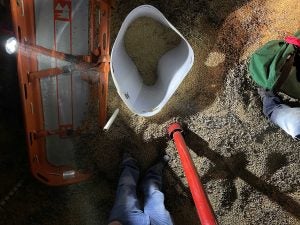
As fate would have it, the reason the tools for the job even existed was because of a board that Coffey himself sat on and their willingness to fund a grant for the equipment needed. The grant was written by Long in 2017 after he and many others on his squad completed grain rescue training under the tutelage of Dale Dobson, Safety Administrator for the Kentucky Department of Agriculture. They presented the grant to the Casey County Ag Development Board — where Coffey is a board member — and were funded to buy the necessary grain rescue equipment for every fire department in Casey County.
Here for another day
Coffey, 71, is a blessed man to still be alive. And he’s aware of it.
A funnel of flowing grain, like what Coffey was pulled into, can entrap someone up to their knees and waist in three to five seconds. They can be engulfed in less than 30 seconds resulting in impending suffocation. The speed of the grain and the force of its weight on you, can lead to entrapment before you are even aware of what’s happening.
In Coffey’s case, he estimates he went from standing on top of the beans to covered up to a few inches above his belt in less than a minute and a half. Even then, it was the PVC pipe getting caught in the auger that prevented him from being sucked under any farther.
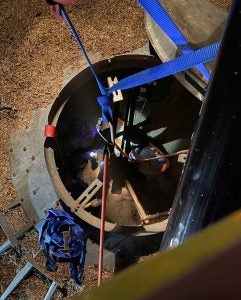
Had the auger continued to run, the force of the grain would have piled against his chest as he got sucked deeper into the funnel. With no pipe to stop it, his foot is likely what would have been wrapped around the auger instead of the PVC pipe. “Had my foot gotten stuck in the auger, I would have bled out before they got me out of there,” Coffey said.
If Coffey’s grain bin had been a larger one — they can easily be 80,000 bushels or more — the amount of grain would have been higher and the chance of rapid engulfment increased. His smaller bin, only ½ to ¾ full, allowed for a chance of survival — one that not everyone gets.
Boots on and back to work
“It was around two hours from the time we received the call to him being on the ground,” Long said.
All in all, Coffey remained in good spirits during the rescue process.
“He was talking to us. We were trying to keep his spirits up. He was pretty upbeat,” Long said. To get Coffey freed from the grain, the team slid a large plastic tube around him and then used a battery operated auger to funnel the grain out between him and the tube.
But Coffey wasn’t interested in letting the rescue squad do all the work. After being freed from the grain, he had another request of the team.
“He asked us to let him down and let him climb out on his own,” Long said.
“I’m geared to be a worker,” Coffey said. “I didn’t want a handout, I wanted to do my part.”
The squad left him harnessed and allowed him to climb out unassisted.
“I got up to the top and looked out and seen all those flashing lights and all those people and labor standing around and thought about going back in the bin,” Coffey said, jokingly.
Once down, Long said Coffey “declined medical help, walked over to his pickup truck, pulled a spare boot out of his truck — he’d lost one of his in the grain bin — and went back to work.”
“I was brought up to work and believe in work and believe in working six days a week, going to church on Sunday, and taking off on Sunday,” Coffey said.
It was only Thursday when the accident happened, and he had no plans of stopping anytime soon. He now works with the belief that the good Lord protected him and he must have survived for a reason, thanks to the Liberty-Casey County Rescue Squad, grain rescue training, and the proper equipment needed.
He and his wife, Katie, now both sit on the Casey County Farm Bureau Board which recently voted to provide the Liberty-Casey County Rescue Squad with $7,500.00 for needed additional grain rescue equipment after Coffey’s rescue.
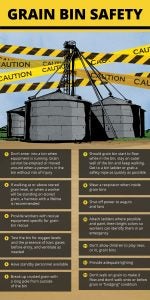
Katie Murray Alt is a lifelong promoter of agriculture and lover of good stories. She enjoys communicating the story of agriculture and of the people behind our industry.



